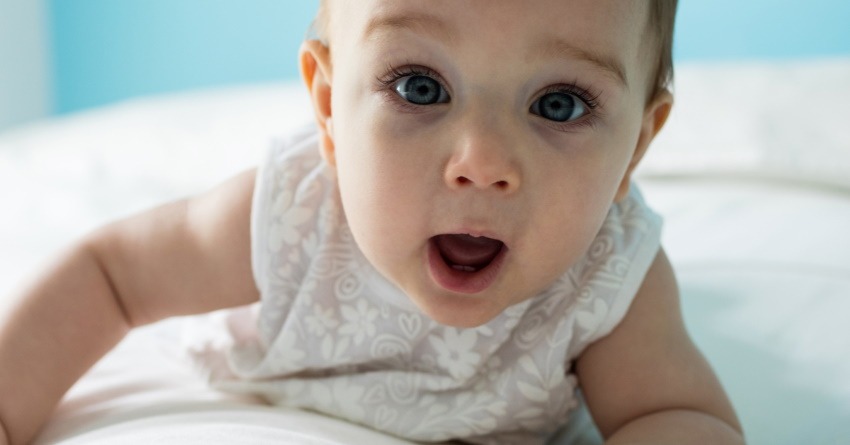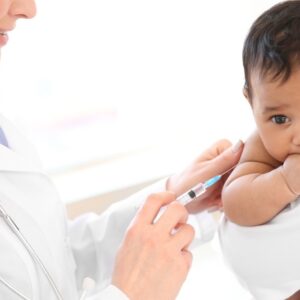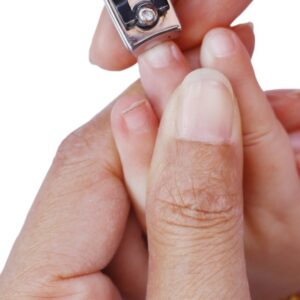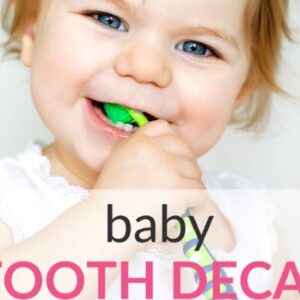Wondering how to get rid of oral baby thrush? You’re not alone.
This article describes efficient natural remedies, symptoms, and causes of oral thrush in babies.

The first time I saw that yellowish, white coating on my baby’s tongue, I had no idea what it was. A quick googling and there I had it – Oral Baby Thrush. A fungus. Yikes!
None of my children have had oral thrush really bad, but bad enough that I had to deal with it and treat them. We never got to the point when it spread or became painful for my child, but that might also be because I treated it in time!
In this post, I go through everything about oral thrush in babies – from how to “diagnose” it and how to get rid of baby thrush using all the great natural home remedies that actually exist. In most cases, natural home remedies work just great!
I hope these tips will be of help! Comment below the post if you need additional tips!
Symptoms, Causes & How to Get Rid of Baby Thrush
In this article…
Causes of Thrush in Babies
Oral thrush in babies is not something most people have heard of before having their first child. But then…
Many babies develop a mild form of this yeast infection during their first months of living. Thrush is caused by the fungus Candida albicans, which we all have in our bodies.
However, if it grows, it can result in different infections. Oral baby thrush is a common problem.
The thrush can come if a breastfeeding mother or the baby has recently been given antibiotics. Another possible reason is a baby’s constant sucking on a pacifier, especially if it is not cleaned regularly. (For tips on how to take care of your baby’s pacifiers, click here.)
The truth is, however, that the reason why so many young babies get oral thrush is actually unknown. Some babies that are not breastfed or use a pacifier also develop this infection.
Baby Thrush Symptoms
Diagnosing Candida or thrush in babies can sometimes be tricky. In babies, oral thrush can be quite similar to a baby simply still having a milk coating on his or her tongue after drinking breast milk or formula.
If it looks as if your baby still has a coating of milk in several places in his/her mouth (not only on the tongue), and the coating does not disappear after a few hours, it can be baby thrush.
 If the coating is thin, easily wiped off, or only visible on the tongue, it is likely to be milk. The picture above shows a borderline case. The baby has a thin coating; it could very well be milk. However, if the coating doesn’t go away, spread, or become thicker, one would suspect oral thrush.
If the coating is thin, easily wiped off, or only visible on the tongue, it is likely to be milk. The picture above shows a borderline case. The baby has a thin coating; it could very well be milk. However, if the coating doesn’t go away, spread, or become thicker, one would suspect oral thrush.
Severe thrush in babies is easier to diagnose. If it looks like your baby has patches of cottage cheese in his/her mouth that don’t wear off easily, it is highly likely your baby may have thrush. If the thrush is wiped or worn off, the area beneath can become raw, red, and maybe even bleed.
 In the image above, you can see an example of severe infant thrush – you can see the cottage cheese-looking fungus on the tongue.
In the image above, you can see an example of severe infant thrush – you can see the cottage cheese-looking fungus on the tongue.
If your baby has symptoms of thrush and the mom is breastfeeding, she may experience breast or nipple pain. This could very well mean that she has been infected, too. Learn all about nipple thrush and how to treat it here.
Another possibility is that you are developing mastitis, another type of breast infection. For mastitis symptoms and remedies, read this article.
When Is Medical Treatment Needed?
In many cases, no medical treatment is needed. However, while uncommon, the thrush can spread through the baby’s body and cause diaper rash. Also, your baby can get a sore mouth. In the above image of severe baby thrush, treatment is definitely needed.
If either mom or baby has disturbing symptoms, go to a doctor.
For your baby, a good start is to ask his or her healthcare provider if the coating you see in the mouth really is a fungus. If it is, then the next question will be whether to medicate with -for example- Nystatin, which is a prescription antifungal liquid, or if available home remedies can be tried as the first option. If the thrush is severe, the best option is probably to medicate.
If the fungus is not widespread or severe, you can try any of the home remedies or alternative cures described below to get rid of baby thrush.

7 Effective Baby Thrush Home Remedies
Here’s how to get rid of baby thrush using several different home remedies.
- Gentian Violet
- Sodium Bicarbonate
- Fresh Lingonberry jam
- Grapefruit Seed Extract
- Wash Toys, Pacifiers, And Breast Pumps
- Eat Lactobacillus Acidophilus
- Air-dry Your Nipples
1. Gentian violet
Some lactation consultants recommend applying gentian violet to your baby’s mouth. Gentian violet is a dye that will stain anything it comes in contact with. Research has shown it to be quite effective, achieving a 75% cure of the illness in 11 days on average, compared to 34 days for an untreated baby.
Before trying this remedy for your baby’s thrush, you should be aware of a recent study raising concerns about the safety of using gentian violet for treating thrush as it may cause cancer in animals if used in large amounts. (You’ll find references to the research at the bottom of this article.)
The remedy has been in use for a long time, and there are no reported incidences of cancer in humans. Discuss with our baby’s doctor if you want to use gentian violet.
If you decide to go ahead, make sure you buy the Gentian Violet 1% solution. Do not use the 2%-solution, which is also often available. You can find the dye at many drugstores or order it from the pharmacy.
Here’s how to use gentian violet for oral thrush in babies:
Use a cotton swab to coat the inside of your baby’s mouth.
When applying the gentian violet, it is easier to ask someone to help you hold your baby. A tip is to undress your baby and make sure that you are not near anything you don’t want to be stained.
Apply the dye once or twice per day for up to three days. You may want to apply Vaseline to your baby’s lips before using the dye to avoid purple lips on your baby.
2. Sodium bicarbonate
Something a lot easier, and probably safer, to apply is water, which contains sodium bicarbonate. Buy carbonated soda water, such as Club Soda, but check that the water really does contain sodium bicarbonate.
If you can’t find Club Soda or similar, you can blend 0.5 teaspoons of sodium bicarbonate (bought in any drugstore) in 0.4 cups (1 dl) of plain water.
Again, use a cotton swab to coat the inside of your baby’s mouth. You should do this after every breastfeeding (if you breastfeed) or as often as you can. I can tell you I certainly did not do it a night with my children, and the baby thrush disappeared anyway.
Coat your nipples, too, since that may help the fungus go away faster.
3. Fresh Lingonberry jam
Yes, lingonberry jam can also be used if you can find it.
Personally, I prefer the sodium bicarbonate treatment because Lingonberry jam has such a strong taste. It seems a bit tough for a baby who has never tasted anything but breast milk or formula.
Treat your baby the same way as if you use sodium bicarbonate water.
4. Grapefruit Seed Extract
Not a commonly known home remedy for thrush, but an effective one! Grapefruit seed extract is very effective in killing microorganisms, including fungi.
To use this remedy, buy a bottle of Citricidal Grapefruit Seed Extract and mix ten drops with one ounce of distilled water. (Do not use tap water; it can make the treatment less effective.) Apply it in your baby’s mouth and your own nipples once every hour and also before every feeding in your baby’s mouth and after every feeding on your nipples.
If you see no improvement after two days, increase the concentration to 15 drops per ounce of water and then finally to 20 drops per ounce. If this is not enough to clear the thrush within a day or two, you should probably discuss medication, such as Diflucan, with your doctor.
5. Wash toys, pacifiers, and breast pumps
To prevent new infections, make sure to wash your baby’s toys, pacifiers, and bottles. It is best to sterilize them in boiling water for at least five minutes or use an electric steam sterilizer. The same goes for the breast pump parts that might be infected.
If you want to be very thorough and get rid of the baby’s thrush for good, you should sterilize all these things after every use while your baby’s treatment is going on. This is, of course, the best.
I confess I didn’t, and it worked anyway. But then, my children only had quite mild attacks of thrush.
You can kill the fungus by washing the products in hot water, boiling them, or soaking them in 10% bleach. Just make sure to rinse anything and put in bleach very thoroughly afterward!
6. Eat lactobacillus acidophilus
Lactobacillus acidophilus is a bacteria that can help keep yeast in check. Eat yogurt that contains these live bacteria cultures or take them in pills. Probiotics have been effective and harmless for babies, too.
You can find probiotics, especially for babies, in any drug store, but make sure it is high-quality. As a positive side effect, probiotics have been shown to have positive effects on infant colic and diarrhea, for example.
7. Air-dry your nipples
Yeast fungus loves moisture, warmth, and sugar. So, one way to get rid of baby thrush is to stop the fungus from growing on your nipples. Do this by washing them and letting them air-dry after breastfeeding as often as you can.
I know it looks very funny to walk around with bare nipples, but it is worth it! Just make sure to tug your sweater down before answering the doorbell…
Video of Infant Oral Thrush Symptoms
Baby Thrush Related Content
- Nipple Thrush Symptoms, Prevention, And Treatments
- All About Mastitis (Breast Infection)
- Breastfeeding Latch Video Gallery
References
Drinkwater, Paul (1990), “Gentian Violet – Is It Safe?”, The Australian and New Zealand Journal of Obstetrics and Gynaecology 30: 65, doi:10.1111/j.1479-828X.1990.tb03199.x.
Young RJ, Huffman S. “Probiotic use in children.”, J Pediatr Health Care. 2003 Nov-Dec;17(6):277-83.
Thomas DW, Greer FR Pediatrics. Probiotics and prebiotics in pediatrics. Pediatrics. 2010 Dec;126(6):1217-31. Epub 2010 Nov 29.
Now, over to you!
So, have you tried any of these baby thrush remedies? Or maybe you have some additional tips on how to get rid of baby thrush? Let us know by commenting below! :-)

Paula Dennholt founded Easy Baby Life in 2006 and has been a passionate parenting and pregnancy writer since then. Her parenting approach and writing are based on studies in cognitive-behavioral models and therapy for children and her experience as a mother and stepmother. Life as a parent has convinced her of how crucial it is to put relationships before rules. She strongly believes in positive parenting and a science-based approach.
Paula cooperates with a team of pediatricians who assist in reviewing and writing articles.







